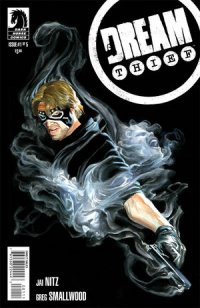The Dream Merchant #1 (Image, $3.50)
By Adam Prosser
Some stories open with a bang. It’s the height of conventional storytelling wisdom—you want to get your audience on board immediately, you need to grab them right out of the gate. It’s not hard to do; open with a character tied to a chair, a gun to their head, and flash back! Show them robbing a bank or assassinating someone! Start with an ultra-dramatic pullback of a recent murder scene, showing how someone’s fallen forty stories out a building! Done well, this kind of thing immediately makes your story stand out and linger in your audience’s memory. Of course, the trouble with these opening firecrackers is that if you can’t back them up with a good follow-through, the whole story can end up seeming like a cheat, a promise that went unfulfilled—a mystery with a resolution that makes no sense, a dramatic sequence that doesn’t properly tie into the larger story. I’m particularly un-fond of the “open at an exciting point in your story and flash back” gambit, which has always struck me as a bit lazy.
The Dream Merchant #1, by Nathan Edmondson and Konstantin Novosadov, does NOT open with a bang. It takes the trickier route of a slow burn, gradually setting the scene as we get to know the hero and his life—how he’s been haunted by a dream his whole life, slowly becoming unable to distinguish between reality and the dream state, until he ends up in a mental hospital. As tragic as this is, it’s not until the halfway point of this double-sized issue that we encounter anything that might be taken as a traditional conflict, as shadowy figures invade the hospital and Winslow, the protagonist, is forced to flee with a hospital employee. The two are rescued by a mysterious Native American (oh boy) who, like the shadowy figures, can apparently invade Winslow’s dreams to protect him, and who promises to teach him how to use his powers.
So in a sense I admire The Dream Merchant for taking a more challenging tack, trusting the audience to be patient and follow Edmondson’s story at its own pace. The problem is that the aspects of the story we do get are, frankly, pretty bog-standard hero’s journey stuff that we’ve seen dozens if not hundreds of times before. I’m not going to say Edmondson HAD to, for instance, let us know the stakes of this conflict, or who the dark powers pursuing Winslow are, but I do think that when the plot hinges on a dream that’s dominated, and arguably ruined, its protagonist’s life, it might be expedient to, for instance, give us more than the barest glimpse of that dream, or let us understand why Winslow finds it so compelling. As it is, it seems to consist of nothing but floating in a vague dreamscape. This leads to a hollowness at the book’s centre. It’s possible that Edmondson has sweeping, original plans for Winslow’s story, but as it is right now I don’t see any particular reason for him to be so damn coy about it. What mystery there is seems like it’s covering, frankly, for a lack of imagination.
There are worthwhile things about this comic; I appreciate Novosadov’s sketchy, not-quite-indie artwork, which has a Fabio Moon-style energy, and the basic storytelling here is rock solid. It’s just employed in the service of a story that gives us little reason to care as of right now. I’m always reluctant to sweepingly condemn a first issue, since so much more of the story remains to unfold, but this comic has 45 pages to make its point, and it’s just barely getting started by the end. If a comic’s not going to grab you by the throat and make you pay attention right from the beginning—and again, I do appreciate the lack of a hard sell—then it’s got to hook you with originality or other unique qualities, and The Dream Merchant doesn’t really manage any of that. It tells the story of a man who’s so caught up in his own dreams that he can’t engage with his life; and it’s a story that, itself, is so caught up in itself that it can’t engage with its audience.
Rating: 




Out of a Possible 5 Stars
 Bikini Cowboy (Fresherluke/Comixology, $5.99)
Bikini Cowboy (Fresherluke/Comixology, $5.99)
by Graig Kent
Originally published last year by a Californian art house boutique press (with a price to reflect it) and simultaneously published to iTunes in four parts, Bikini Cowboy recently came available through Comixology for $5.99 (incredibly reasonable for a 377 page book).
An anachronistic western with a jubilant yet badass protagonist, Whiskey Jill is like an old-west, not-as-violent Tank Girl who roams the desert in a bikini with a surfboard under her arm and a whip wrapped around her waist. The bikini thing seems like a titillating gimmick in premise but story wise it has relevance (really..its a choice the character has made, partly the byproduct of having trained as a witch with a Hawaiian sorcerer). It also not just an abstract element of the book but quite frequently addressed by the characters around her. The crux of the story finds Jill taking Rod — a tween-ish orphan boy with a special, desirable skill — into her care as he’s pursued by his nasty, exploitative guardian and she’s pursued by The Marshall, a violent man of God who really doesn’t cotton to Jill’s liberal ways.
The book makes a strong, confident protagonist out of Jill and doesn’t sexualize her to any overt degree. It’s partly that creator Luke Weber’s cartooning style doesn’t lend itself to sexiness, and also because I don’t believe it’s his intent to sexualize her any more than any woman comfortably wearing a swimsuit in hot weather should appear (one scene excepted, told from young Rod’s POV as he wakes to find Jill bathing in the pond before him… his first awareness of sexuality). At the same time the men of the 1800’s can’t help but sexualize Jill for her not-of-the-era attire, tossing all manner of derogatory slurs her way. Too many in fact. Given Weber’s innocent illustrations it’s a stark juxtaposition against the crassness of the language. Imagine if Rango’s dialogue were supplanted by Deadwood’s. It’s not the only uncomfortable element to Bikini Cowboy, as Jill frequently plays into Rod’s boyhood crush on her, feeling uncomfortably close to pedophilia rather than playful as I think was intended. It’s a precarious line which Jill toes too often.
Weber’s an amazing draughtsman , and his pages look great. The western environment is wonderfully and richly detailed without overpowering the simplicity of his characters. There’s a bisqueness to the pacing of the book and the abundant reference to religion seem to recall Doug Ten Napel’s work but Weber puts more care into his pages (TenNapel frequently works freehand and steam-of-consciousness) and Weber’s view is more an indictment of religion (the worst people in this book are the Bible thumpers), instead celebrating spirituality.
It’s not a perfect read but it is generally quite charming, unique, and certainly more than worth its modest digital price.
Rating: 




Out of a Possible 5 Stars
Dream Thief #1 ($3.99, Dark Horse)

by D.S. Randlett (@dsrandlett)
I’m not a big believer in the spoiler. That is, I think that many of us are way too paranoid about them because the idea of the spoiler has so skewed how we choose to experience fiction. Of course, just as I’m telling myself this, I decide to read and review something that is extremely hard to not spoil, in the truest sense of the word. So much of what this book brings to the table comes across in the moment of experiencing it, and so many of the character and plot beats are bound up in that experience in a way that’s not typical of genre fair. It’s a bit like Nolan’s Memento in more ways than one, but mainly in that one of the core appeals of the story is not only in seeing what “happens,” but in the meticulously unfolding way that it is told.
What I can say is that we have a sort of supernatural/superhero version of Billy Wilder’s The Lost Weekend that happens to be pretty grungy and violent. It’s also one of the better first issues I’ve come across for quite a few months. Writer Jai Nitz succeeds not only in crafting a grimy, noirish story (Ed Brubaker fans will feel quite at home here) but more importantly in drawing the reader into his protagonist, a character that’s been thrown into a world of mystery while holding back mysteries of his own. The mysteries here don’t feel at all hack, as they often are in the post-J.J. Abrams world of genre writing, where a sense of mystery is used to cover up the lack of a compelling central conflict. Even though we’re left with a bunch of questions (Who? What? Why?) by this issues last page, there is the solid feeling of an actual story here.
Artist Greg Smallwood turns in some brilliant work here. He translates the book’s Atlanta setting into something that feels like it comes for the great Southern California noir tradition (think Denis Johnson’s Already Dead), at once giving the story a tangible and realistic sense of place and a tripped out, gothic feel. His characters and layouts are also extremely appealing, reminiscent of Sean Philips’ work, but with a more humid feel.
To say anything about Dream Thief besides “It’s quite good!” would rob you of the experience of being surprised by what you find. If the rest of the run lives up to this first issue, then we’re in for a treat, but for now it’s well worth getting in on the ground floor on something that has a great deal of potential.
Rating: 




Out of a Possible 5 Stars
 Clockwork Watch: Breakaway (available from clockworkwatch.com)
Clockwork Watch: Breakaway (available from clockworkwatch.com)
By Jeb D.
It can be hard enough picking up a comic series after it’s established itself, but there’s at least the theoretical possibility of going back to the earlier volumes and following the storyline organically; but when the “story” of a comic is unfolding in real time, in places ranging from the theatrical stage to sci-fi conventions to flash mobs, it’s kinda tough not to feel that you’re missing out.
The Clockwork Watch, whose first installment we reviewed here, takes its steampunk setting into “…an immersive, multi-media experience, that will extend to online role-play, live theatre, video, street markets…” , and doubtless any other media that “transmedia producer and digital strategist” Yomi Ayeni, creator of the concept, can dream up, abetted by scripter Corey Brotherson and artist Jennie Gyllblad.
Set in an alternate Victorian England, The Clockwork Watch posits the development of 19th century steam-powered robotic technology, reaching its peak with the creation of mechanical beings: clockworks, or “clocks.” The difficult relations between England’s human labor force, its church, and these indentured workers, forms the backdrop of this latest chapter (the second of three volumes) in the story of Janay, a young boy transplanted with his family from his home in India. In the previous volume, Janay acquired his own clock, Ashwin, as well as encountering a level of prejudice that would seem to belie a more “liberal” Victorian society, where an Indian scientist like his father can hold a high governmental position: for all their societal advancement, cruelty and hatred can still run deep.
Breakaway picks up the story twenty years later, when a young man’s full lifetime of hatred and family conflict have hardened and embittered Janay. His child’s view of the wonders of technology has soured into a deep resentment, entangling him with the “lower orders” and a violent resistance movement.
That’s all well and good with the narrow focus on Janay’s life, but too much of the world-building that makes Janay’s story interesting is happening “off camera,” either in other media, or in the two-decade gap between volumes: to really “get” the setting and background requires a fair amount of catch-up in Brotherson’s extensive backmatter (and even at that, a perusal of the clockwork.com website reveals newspaper stories, journal entries, and characters being created by fans and participants at least as interesting as anything happening in the comics).
Ayeni, Brotherson and Gyllblad have put a commendable amount of effort into ensuring that their steampunk universe has a purpose beyond “looking cool,” with its depiction of prejudice, and the placement of religion and organized labor in opposition to technology. The world-building, though, has a kind of 21st century quality to it: technological advances involve a lot of newly discovered elements doing more or less magical things; while the development of a Victorian society which gives places of responsibility to women and minorities really needs more than the cursory attention given in the comics.
Anyone who enjoyed the first volume of Clockwork Watch will certainly want to continue following the developments in Janay’s story. Gyllblad’s artwork has acquired a bit more polish, and her use of watercolor shades the emotions of the story even more effectively than last time. But for all its strengths, this is still the middle volume of a story whose most interesting elements don’t always take place within its actual pages.
Rating: 




Out of a Possible 5 Stars